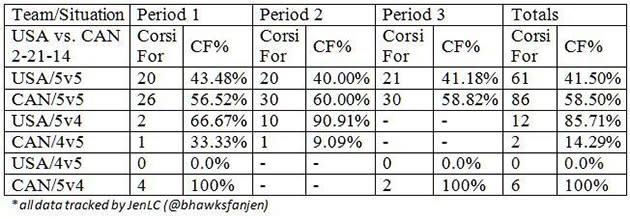How Canada humbled Team USA’s offensive machine in Olympic win
SOCHI, Russia – The meeting between the U.S. and Canada in the Sochi Olympic semifinals was a meeting between the tournament’s best offensive and defensive teams.
As the saying goes: Defense wins championships.
Offense, it seems, plays for bronze.
The Canadians played a puck possession game, didn’t allow the Americans to establish anything in the offensive zone and smothered them on the penalty kill. It was a reminder that Canada doesn’t simply have an assemblage of goal-scoring talent – they have some of the greatest two-way players in the sport.
"They came at us with 20 guys,” lamented U.S. Coach Dan Bylsma after the game. “They came at us with speed and they came at us for 60 minutes and that was a fast game. That was as fast a game as I've ever been a part of. There was lots of speed out there, up and down the ice, and we weren't able to counter that as much as we'd like."
In 60 minutes, the Americans were transformed from a team that had utilized the larger ice surface in Sochi into one that looked offensively uncreative. You can count on one hand the number of quality chances the U.S. had against Carey Price; you can count on one finger the number of long passes that connected from their defensive zone to the attacking zone: Kevin Shattenkirk hitting Patrick Kane on a three-zone pass in the second period.
In the Canadians, the U.S. faced three things they hadn’t faced in scoring 20 goals in their first four Olympic games:
1. Depth
Canada was able to throw complete defensive units against the Americans’ two top scoring lines. Duncan Keith and Shea Weber were deployed against Phil Kessel and James van Riemsdyk, one of who had points on the first goal in each of the previous four U.S games. So was Jonathan Toews’ line. When it wasn’t Keith and Weber, it was Drew Doughty and Marc-Edouard Vlasic. They didn’t allow anything from the duo: Kessel had four shots, JVR had two shots and nothing behind Carey Price.
Sidney Crosby’s line won the battle against the “Meat Line” of the U.S. Cam Charron of The Eh Game writes that Crosby, Chris Kunitz and Patrice Bergeron out-chanced the Americans 10-3 at even strength.
There was no weak link in the Canadian lineup, no matchup the U.S. could hope to exploit.
2. Puck Possession
Jen LC of Second City Hockey kept tabs on the possession numbers for the game, and to the surpirse of no one they heavily favored the Canadians.

For the uninitiated, “Corsi For” tabulates any shot attempt that’s directed on the opposing goal, minus any shot attempt on their own goal.
The numbers show the absolute domination of the Canadians in each period, as the Americans had a series of “one and done” offensive chances. Meanwhile, Canada cycled and cycled and dominated the U.S. in their own zone.
“That’s how you eliminate a team like that, you make them play in their zone and control the puck,” said Patrice Bergeron.
3. Nothing In Front Of Price
Carey Price made 31 saves, but was quick to credit his defense for making many of them easy.
“That defensive group in front of me played very well,” he said. “They’re very good at boxing guys out and let me have my eyes. Our forwards backchecked really hard tonight. I think that was the difference.”
This really was the difference in the game. The Americans had amassed 20 goals in the tournament with speed, playing chip-and-chase against lesser foes. But Canada’s blue line wouldn’t allow them any time to set up a cycle, nor would they allow any time to set up in front of Price.
“I think it was maybe a little too perimeter and not much traffic in front of their net,” said David Backes. “Kudos to them for keeping us to the outside, but we’ve got to find ways to get to the inside and make things happens. There was not enough of that tonight. As a result, we don’t get any goals and you can’t win when you don’t score.”
No kidding. The Canadians simply didn’t allow the U.S. offense a sniff all night. The game was 1-0; the margin of victory felt much larger.
“They managed the puck pretty well and played a real suffocating style of defense. We didn’t battle through it in quite the ways we needed to to have success. The result is no second and third chances that we’ve been scoring on earlier,” said Backes.
Brooks Orpik said after the game that the U.S. didn’t alter its game plan.
“We wanted to push the pace. I think you just got to credit them. They got great players and their game plan was really good. They clogged up the neutral zone really well,” he said. “A lot of teams sit back on the big ice. They didn't sit back, that's for sure."

 Yahoo Sports
Yahoo Sports 


